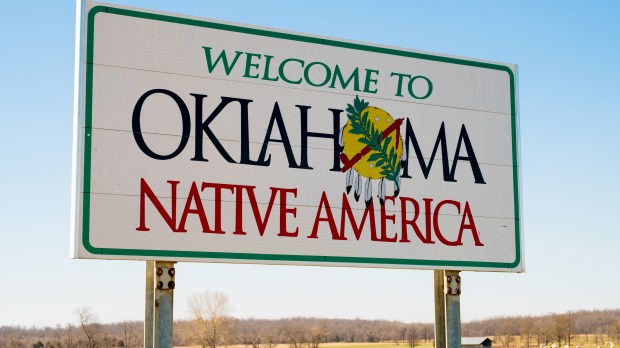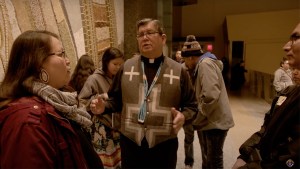While visiting Canada this week, Pope Francis said that the Catholic Church will cooperate in further investigating what occurred at Native American residential schools and will walk with survivors in their journey toward healing.
That process has already begun in the United States.
The pope’s visit, which he described as a penitential pilgrimage, began with an apology for the Catholic Church’s involvement in a long-standing state-run system meant to assimilate Indigenous people in Canada. Thousands of young people were taken from their families and forced to live in boarding schools where they were not allowed to use their native languages, traditional attire, or tribal customs. The system began in the 19th century, and the last schools closed in 1997. Many alive today were students at the schools, and some have reported having suffered there.
The United States had a similar system, beginning when Ulysses S. Grant was president. One area of the country where residential schools operated — with the help of the Catholic Church and other religious bodies — was Oklahoma. Last year, the Archdiocese of Oklahoma City, the Diocese of Tulsa, and St. Gregory’s Benedictine Abbey, which was the earliest Catholic presence in Oklahoma, launched the Oklahoma Catholic Native Schools Project and commissioned a historian to research the extent of the Church’s involvement.
“The project is really to explore our history,” said Michael Scaperlanda, chancellor of the Archdiocese of Oklahoma City. “This really started as we were reading about the Canadian experience. We really didn’t know about how our Catholic Native American boarding schools operated, and what people’s experiences were.”
In a statement, Archbishop Paul S. Coakley, Archbishop of Oklahoma City, said, “It is important we learn and understand the experiences of American Indian children and their families at Catholic boarding schools in Oklahoma so we can make better and more informed decisions moving forward. We will continue to build a culture of inclusion, healing and understanding related to Native American Catholics in our state.”
The archdiocese, diocese and abbey will work with Marquette University in Milwaukee, which holds the archives for the Bureau of Catholic Indian Missions. Marquette professor Bryan Rindfleisch, who specializes in American Indian history, has already delved into hundreds of historical documents. Researchers in Oklahoma will conduct oral histories.
“It is by understanding the past that we are able to improve and build on good ideas in the present and, where necessary, make amends for failures in the past,” said Bishop David A. Konderla of Tulsa.
Targeting children
Eleven Catholic Indian boarding schools existed in Oklahoma between 1880 and 1965. The first one opened in Konawa in 1880 and closed in 1926. The last Catholic Indian boarding school, Saint Patrick’s in Anadarko, closed in 1965. They were all overseen by various religious orders.
In an interview, Rindfleisch said that Oklahoma was the largest center of Indian boarding schools in the U.S. “Roughly one-third of the entire Catholic Native American population in the 19th and 20th centuries was centered in Oklahoma,” he said. Though some religious orders who were involved in the residential school system have already been documenting that history, Rindfleisch believes that Oklahoma City is the first American archdiocese to undertake such an effort at research and reconciliation.
The Society of Jesus – the Jesuits – in the US said on its website they have “sorrowfully acknowledged the Society’s participation in these assimilation policies which separated families and suppressed Native cultures, contrary to core tenets of our Catholic faith. We are examining this part of our history and making available the records we hold so others may do so as well. Openness, transparency, and knowledge of our history are essential elements for reckoning with the sins of our past and moving forward together toward healing.”
Rindfleisch said that uncovering the history of the schools matters to him because “there are still generations of survivors who went to those boarding schools, who had lost loved ones in those boarding schools, who have physical, sexual and emotional trauma and abuse on account of those boarding schools.
“I have never met an Indigenous person, scholar, community member, friend [who didn’t] have boarding school stories in their family,” he added.
After the Civil War and various military operations that the US government called “wars of conquest,” there was an effort to assimilate Native peoples into American society. Richard Henry Pratt, the architect of the Indian boarding schools, was known for the saying, “Kill the Indian to save the man.”
“His idea was to take all the children, put them in schools, raise them according to Western ideals and education and civilization – you know, industrial arts, farming, agriculture – but then tell them they can’t speak their language and must cut off their hair, cut off their various customs that are tied to their identity,” Rindfleisch said. “Give them civilized clothing, give them Christianity.”
He said children were targeted because “they are the future generations, and they will teach their children and their children, and then hopefully, the Indian peoples, the parents and the grandparents, will just die off. This is the one example where we can often pinpoint that this was a genocidal policy on the part of the United States, starting in the 1870s and continuing all the way up to the 1970s.”
Types of abuse
Rindfleisch said “hundreds of thousands” of Native American children from all over the United States were placed in residential schools, away from home so their parents could not maintain some sense of history, culture and identity for them.
As well, problems of abuse crept in.
“These boarding schools are rife with what are called disciplinarians, even at the Catholic schools,” Rindfleisch said. “How do you enforce taking the language away from them, forcing them to go to church, to become Christians or acclimate to Western ideas of education? Well, you verbally and physically abuse them.
“And in some cases there’s also sexual abuse,” he continued. “You have figures of power – predominantly men – who are taking care of all these different children. You just look at the Catholic clergy scandal: men who are in positions of power. When they have that power over children it can lead to horrible, horrendous things, and that’s what happened in this case too. And the one thing that we learned from the clergy abuse scandal is that they swept it under the rug and they wanted to put various members away: put them in a place where they’re out of the limelight. And what better place to do that than oftentimes reservations, which people in general just didn’t care about.”
Not all horror stories
Rindfleisch admits there were bright spots as well, and there are Native American alumni today who have good stories about the schools.
“For some people the boarding schools were good places,” he said. “If you lost your parents and grandparents, the school could save the kid’s life.”
And many tribes already had been evangelized by Catholic missionaries.
“A number of Native Nations that were removed to Oklahoma from other parts of the country in the 19th century already had Catholic missionaries among them for decades,” Rindfleisch said. “So if they had to choose between Protestant, federal or Catholic boarding schools, they wanted Catholic boarding schools.”
And in some places, the Church could go to bat for their Native parishioners, such as representing them to the government in cases of land disputes. Some Native Catholics, Rindfleisch said, gently reminded pastors that their kids were in the Catholic school, so they should advocate for them.
Burying the dead
Nevertheless, many students died at the residential schools, a fact, Rindfleisch said, that can be attributed to disease, malnutrition, accidents, and in some cases abuse. Too often, the bodies of students were never returned home, and now many of them are lost.
“A big part of what needs to happen after this – I think this is the legacy for the Archdiocese of Oklahoma City and the Diocese of Tulsa going forward – is trying to figure out what happened to the bodies of those children,” the historian said.
When he spoke with Aleteia in June, Rindfleisch said a good friend of his was visiting the school Richard Henry Pratt ran in Carlisle, Pennsylvania, reclaiming one of her ancestors who had died there.
“She has to go up there with a couple of elders who have to conduct this long ceremony so they can purge these children’s remains of all that bad history, so they can bring her home,” he said.
Rindfleisch said he has gone through the entire Bureau of Catholic Indian Missions records at Marquette – about 900 boxes – and has been to various archives of parishes in Oklahoma, as well as the records of the archdiocese and the Diocese of Tulsa. He’s also been working with the Sisters of Divine Providence and other religious orders that were involved in the schools. He will be collecting oral histories of any boarding school survivors who want to be a part of the project.
“And early next year I’ll start drafting,” he said. “By the end of 2023 we want to have something.
“The big thing that really needs to happen in terms of Native American history with the United States government, with the Catholic Church, with all of the churches, is just owning the pain and trauma that we created for these legacies,” Rindfleisch concluded, “these generations of Indigenous populations who are still coming to terms with what’s happened to them.”



